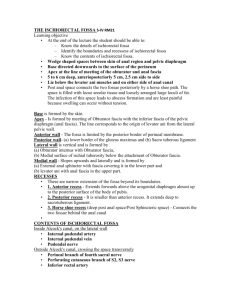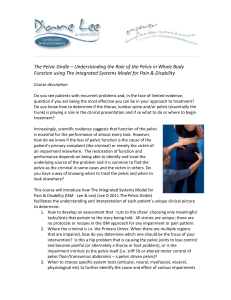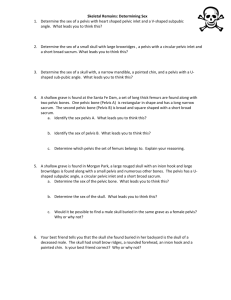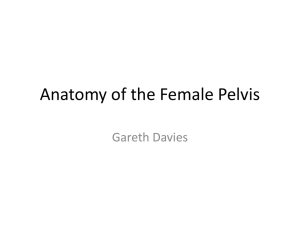The female levator ani muscle
advertisement
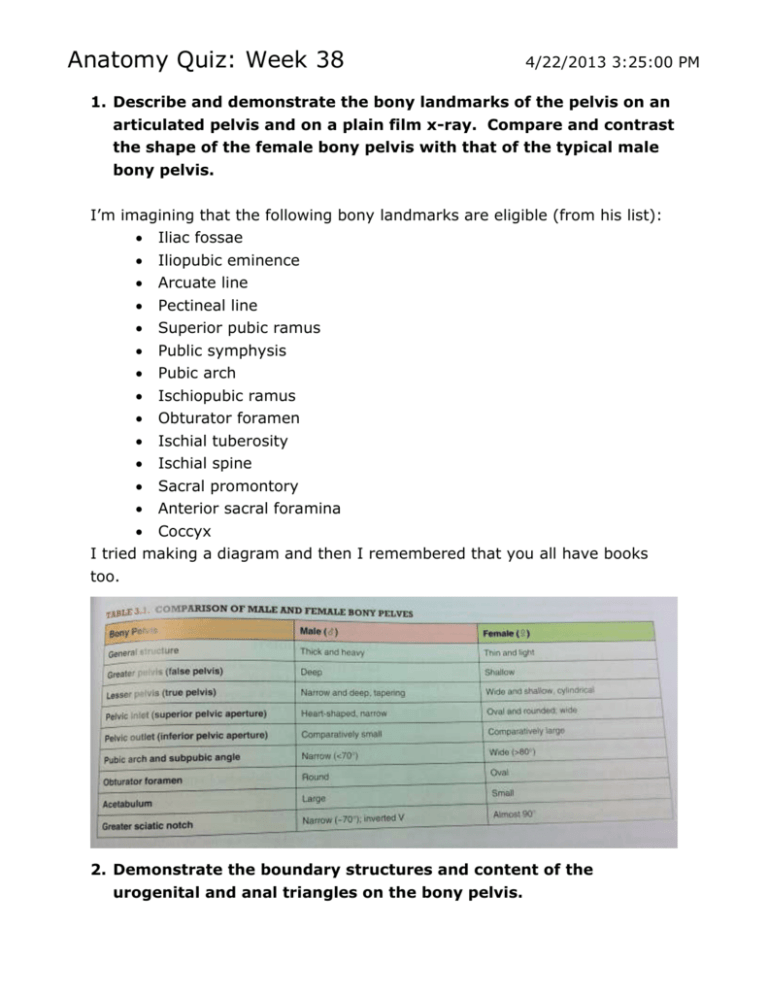
Anatomy Quiz: Week 38 4/22/2013 3:25:00 PM 1. Describe and demonstrate the bony landmarks of the pelvis on an articulated pelvis and on a plain film x-ray. Compare and contrast the shape of the female bony pelvis with that of the typical male bony pelvis. I’m imagining that the following bony landmarks are eligible (from his list): Iliac fossae Iliopubic eminence Arcuate line Pectineal line Superior pubic ramus Public symphysis Pubic arch Ischiopubic ramus Obturator foramen Ischial tuberosity Ischial spine Sacral promontory Anterior sacral foramina Coccyx I tried making a diagram and then I remembered that you all have books too. 2. Demonstrate the boundary structures and content of the urogenital and anal triangles on the bony pelvis. Urogenital Δ Boundaries: the vertices of the triangle are at the public symphysis and the two ischiopubic rami. It is the anterior triangle of the perineum. Contents: o Bulbospongiosus, ischiocavernosus, transversus perinei superficialis mm. o Crus of penis/ clitoral crura o Urethra o Bulbourethral gland (male)/ Bartolin’s gland (female) o Penis bulb, (yup) / vestibular bulb o Posterior scrotal or labial nerves Anal Δ Boundaries: the vertices are at the coccyx and the two ischiopubic rami. Posterior triangle of the perineum Contents: o Sacrospinous & sacrotuberous ligaments o Pudendal nerve o Internal pudendal a/v o Anal canal o Muscles Sphincter ani externus Gluteus maximus Obturator internus Levator ani Coccygeus o Ischioanal fossa 3. Describe the boundaries of the ischiorectal fossa from a posterior approach and describe the construction, attachments and functions of the components of levator ani in a female. The ischiorectal fossae are fat-filled, wedge-shaped, fascia-lined spaces between the pelvis diaphragm and the perianal skin. The boundaries are: Laterally; ischium, inferior obturator internus m., obturator fascia Medially; external anal sphincter, levator ani m. Posteriorly; sacrotuberous ligament, gluteus maximus Anteriorly; pubic bodies, inferior to the origin of puborectalis. The female levator ani muscle Puborectalis o Forms the sling for the rectum o Originates from inferior public symphysis and insert on the opposing puborectalis muscle o It lets you hold in a load when it might not be socially acceptable to dump it (wait, girls poop?) o N: S3, S4 Pubococcygeus o Hammock-shaped muscle from pubis to coccyx and forms the floor of the pelvic cavity o Joins iliococcygeus in forming the anococcygeal raphe o Controls urine flow, aids in childbirth, contracts during orgasm o N: S3, S4 Iliococcygeus o The most posterior of the group, from the ischial spine to the anococcygeus raphe, via the tendinous arch of the obturator fascia o Pulls the coccyx side to side and elevates the rectum o N: S3, S4 4. Describe the spermatic cord fascial layers including their embryological origin from the anterior abdominal wall structures. 3 Layers External Spermatic Fascia o derived from external oblique muscle o outermost covering of spermatic cord (& testes) Cremasteric Fascia o derived from internal oblique muscle Internal Spermatic Fascia o derived from transversalis fascia 5. Contrast and compare the arrangement of erectile tissue in the male and female genitalia. Male: 3 cylindrical cavernous bodies Paired corpora cavernosa dorsally Single corpus spongiosum ventrally The anatomical position for the penis is while erect. So dorsal is the side that’s easiest for his owner to view. Female: way more complicated than previously thought… Clitoris o At the anterior juncture of labia minora o Composed of two crura, two corpora cavernosa, and glans Glans is highly innervated Crura attach the clitoris to the inferior pubic rami Body of clitoris is covered by prepuce Bulbs of the Vestibule o Paired elongated masses of erectile tissue along the vaginal orifice, deep to the labia minora. o Homologous to the male’s bulb of the penis And, in conclusion, I present these schematics. Way more similar that I imagined. Gravy. 6. Compare and contrast the course of the urethra in the male and the female. Male (18-22cm) 1. Intramural / Preprostatic 1.5cm, vertically from the bladder, size depends on bladder status 2. Prostatic 3-4cm, descends through anterior prostate, very distensible 3. Intermediate (membranous) 1.0-1.5cm, through deep perineal pouch 4. Spongy Through the corpus spongiosum and out into the external environment Length doesn’t matter, right? Female (4cm long) From the internal urethral orifice of bladder, descends posterior to the pubic symphysis and then inferior to it, to the external urethral orifice. This is located in the vestibule of the vagina. 7. Trace the fascial layers of the abdomen as they descend into the pelvis. As your cross into the pelvic region, Camper’s subcutaneous fatty fascia could be present in variable amounts, and probably gets renamed in the pelvis. The deep investing fascia from the abdominal muscles continues as the outer fascial covering for pelvic musculature (piriformis, obturator internus…). The final layer is the endoabdominal (aka transversalis fascia). This becomes the pelvic fascia proper and can be divided into parietal and visceral layers. The parietal layer invests the deep aspects of pelvic musculature and the floor of the pelvis. Often, regions are named for the muscle it is directly covering. The visceral layer directly forms the adventitial layer of the pelvic organs. Where organs penetrate the pelvic floor, the parietal and visceral will blend together.





